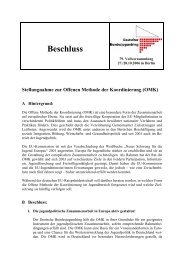6 Country Reports on Youth Work - Jugendpolitik in Europa
6 Country Reports on Youth Work - Jugendpolitik in Europa
6 Country Reports on Youth Work - Jugendpolitik in Europa
You also want an ePaper? Increase the reach of your titles
YUMPU automatically turns print PDFs into web optimized ePapers that Google loves.
Table 33: <strong>Youth</strong> workers <strong>in</strong> Greek municipalities<br />
Type of Service Total Employed Pers<strong>on</strong>s % Number of Volunteers %<br />
Cultural youth work 48 22 46% 26 54%<br />
Extracurricular youth educati<strong>on</strong>. 70 70 100% 0 0%<br />
Children and youth recreati<strong>on</strong> 30 8 27% 22 73%<br />
Open youth work, youth clubs, etc. 51 28 55% 23 45%<br />
<strong>Youth</strong> associati<strong>on</strong>s and youth groups 67 4 6% 63 94%<br />
Street work/ Mobile youth work 0 0 0% 0 0%<br />
Sports 37 35 95% 2 5%<br />
<strong>Youth</strong> counsell<strong>in</strong>g 109 19 17% 90 83%<br />
Advised (Adventure) playgrounds 23 23 100% 0 0%<br />
Internati<strong>on</strong>al youth work 3 2 67% 1 33%<br />
<strong>Youth</strong> social services 10 10 100% 0 0%<br />
<strong>Youth</strong> educati<strong>on</strong> (with<strong>in</strong> the formal system) 10 10 100% 0 0%<br />
<strong>Youth</strong> employment/career services 5 5 100% 0 0%<br />
<strong>Youth</strong> <strong>in</strong>formati<strong>on</strong> 17 15 88% 2 12%<br />
This list shows that the greatest percentage of volunteers, 94%, is to be found <strong>in</strong> youth<br />
associati<strong>on</strong>s and youth groups as expected, but also <strong>in</strong> the categories of youth counsell<strong>in</strong>g,<br />
youth recreati<strong>on</strong> and cultural youth work.<br />
60% of youth workers at local level are full-time employees, 4% part-time employees, and<br />
36% have a <strong>on</strong>e-off c<strong>on</strong>tract with the municipality.<br />
Regard<strong>in</strong>g the qualificati<strong>on</strong> of youth workers, differences were noted between youth workers<br />
employed <strong>in</strong> the sector of educati<strong>on</strong> and social youth work and those active <strong>in</strong> other fields of<br />
youth work. While the percentage of youth workers with a higher qualificati<strong>on</strong> is nearly equal,<br />
the percentage of youth workers with no formal educati<strong>on</strong> is much higher <strong>in</strong> the field of youth<br />
work that is not related to educati<strong>on</strong> or social services.<br />
Table 34:Qualificati<strong>on</strong> of youth workers <strong>in</strong> Greek municipalities<br />
higher educati<strong>on</strong> professi<strong>on</strong>al school no formal educati<strong>on</strong><br />
Educati<strong>on</strong>al/social services 55% 38% 7%<br />
Rest youth work services 53% 5% 43%<br />
Data about participants <strong>in</strong> youth work is difficult to obta<strong>in</strong> at local level too. Not all<br />
municipalities were able to state numbers of participants, so that the data gives <strong>on</strong>ly a rough<br />
overview. Children and youth recreati<strong>on</strong>, cultural youth work and open youth work are the<br />
activities that reach the greatest number of children and young people. The ratio between<br />
female and male participants is nearly equal, more girls that boys are to be found <strong>in</strong> the fields<br />
of cultural youth work, open youth work and youth social services, while boys more often<br />
attend activities such as sports and extracurricular youth educati<strong>on</strong>.<br />
83

















